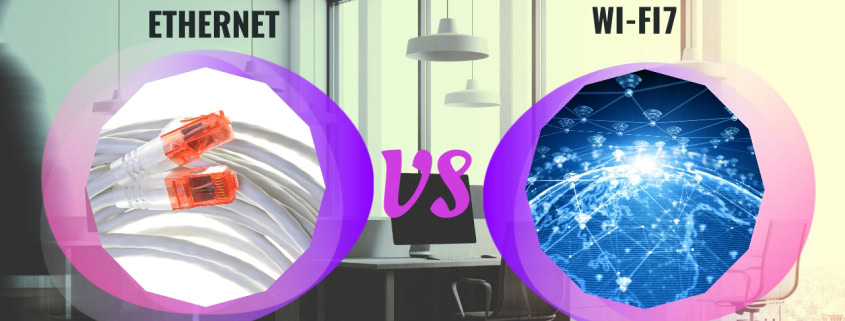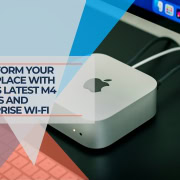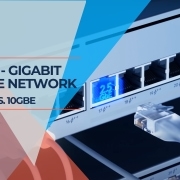Is WiFi 7 the End of Wired Offices?
Last Updated on April 20, 2024
Is WiFi 7 Fast Enough to Kill Wired Office Networks?
Picture a modern office. You likely imagine sleek laptops, wireless printers, and employees moving freely without the tangle of cords. But behind the scenes, a network of Ethernet cables still powers much of this seamless connectivity. Wireless connections have been the backbone of offices for years, but a revolution is brewing. WiFi 7, the latest and most powerful wireless standard, promises speeds that might finally rival those of traditional wired networks. Could this be the turning point where offices ditch cables altogether? As with most tech advancements, the answer isn't a simple yes or no.
Table of Contents
What is WiFi 7?
Let's break down the buzz. WiFi 7, officially known by the less catchy IEEE 802.11be, is the next giant leap in wireless networking. Building upon its predecessors, WiFi 7 focuses on delivering jaw-dropping speeds, incredibly low latency (the time it takes for data to travel), and the ability to handle a massive number of connected devices – all essential for the modern workplace.
WiFi 7's Secret Sauce
So, what makes WiFi 7 so special? Here are some key features:
Multi-Link Operation (MLO): Imagine this as multiple “lanes” for your data. MLO lets a device connect to different frequency bands simultaneously, boosting speed and reliability.
Higher 4K QAM: This tech packs more data into each transmission. Think of it as using a bigger suitcase to carry your files.
Wider 320 MHz Channels: Picture these as wider highways for data. Wider channels significantly increase potential speeds.
Key Wi-Fi 7 (IEEE 802.11be) wireless specs:
| Specification | Wi-Fi 7 (IEEE 802.11be) |
|---|---|
| Maximum Theoretical Speed | Up to 46 Gbps |
| Frequency Bands | 2.4 GHz, 5 GHz, 6 GHz |
| Channel Width | Up to 320 MHz |
| Modulation | 4096-QAM (4K-QAM) |
| Multi-Link Operation (MLO) | Yes |
| Other Notable Features | Enhanced efficiency features, better channel utilization, reduced latency |
Important Notes:
- Theoretical Speed: The maximum speed is a theoretical value. Real-world speeds will be lower due to various factors, such as distance, interference, and device capabilities.
- Availability: Wi-Fi 7 devices are still relatively new and may be more expensive initially.
WiFi 7: The Pros
WiFi 7's upgrades aren't just theoretical. They translate into real-world benefits that could transform how we work:
Blazing Fast Speeds
WiFi 7 can reach a blistering maximum speed of up to 46 Gbps on paper. To put that into perspective, it's fast enough to download a high-definition movie in seconds. Even current, top-of-the-line wired Ethernet connections often max out at 10 Gbps. With WiFi 7, those cables might start looking a little less appealing.
Reduced Latency
Latency is the enemy of real-time collaboration. WiFi 7 aims for minimal delays, which is crucial for video calls, online gaming, and virtual and augmented reality technologies. Imagine crystal-clear video conferences without frustrating lags or stutters.
Increased Device Capacity
Think of crowded workplaces crammed with laptops, phones, smart devices, and printers all vying for bandwidth. WiFi 7 is designed to handle this onslaught, ensuring a smooth experience even when the office is buzzing with connected tech.
Enhanced Flexibility and Deployment
No more tripping over wires or calling an electrician whenever you rearrange desks. WiFi 7 allows for a cleaner, more adaptable office layout. Need to set up a temporary workspace? With WiFi 7, you can do it in minutes.
WiFi 7: The Cons
While WiFi 7 sounds incredible, like any technology, it has limitations. Here's what you need to consider before making the leap:
Potential Interference
Although WiFi 7 operates in the less crowded 6GHz band, it's not immune to interference. Existing devices using this band may cause performance hiccups, especially in dense environments.
Reliability Concerns
It's a hard truth: Wired connections are generally more reliable than wireless ones. While WiFi 7 improves upon its predecessors, disruptions and signal drops, though less likely, can still occur. A wired connection might still provide greater peace of mind for mission-critical systems.
Security Considerations
Wireless networks face inherent security risks compared to wired ones. Even with robust encryption, they may be more susceptible to hacking attempts. Organizations handling sensitive data must implement extra security measures when using WiFi 7.
Cost and Availability
Upgrading to WiFi 7 can be expensive. You'll need compatible routers, access points, and devices. This initial investment might be a barrier for some businesses, especially smaller ones.
Hybrid Solutions: The Best of Both Worlds
Instead of an all-or-nothing choice, a hybrid approach could be the smartest solution for many businesses. This strategy leverages the strengths of both wired and WiFi 7 technologies, creating a reliable and flexible network.
A Balanced Approach
Here's how a hybrid approach might work:
Wired for the Critical: Mission-critical systems, like servers handling sensitive data or applications requiring ultra-low latency, could still benefit from the reliability and security of wired connections.
Wireless for the Rest: General office use, laptops, tablets, and smart devices are perfect candidates for WiFi 7, offering speed, ease of movement, and reduced clutter.
Seamless Integration
The key to a successful hybrid network lies in smooth integration. A well-designed network infrastructure ensures devices can effortlessly switch from wired to wireless connections depending on location and task. This kind of seamless experience is what makes hybrid setups especially appealing.
Is WiFi 7 the End of Wired Office Networks?
A Nuanced Answer
The simple answer is that it depends. Technology is always evolving, making it difficult to predict the future completely. WiFi 7 is game-changing, but whether it completely replaces wired networks hinges on several factors.
Not Entirely, But a Major Shift
While it's unlikely that cables will disappear overnight, WiFi 7 has the potential to change the way we think about networking. It offers speeds and features that will dramatically reduce the need for wires for many common office tasks. Picture fewer cable runs, cleaner setups, and more flexible workspaces.
Future Outlook
As WiFi technology matures, limitations like potential interference will likely be addressed. Costs will come down, making wider adoption more accessible. If this rapid evolution continues, WiFi might become the default choice for most offices, confining wired connections to a specialized niche.
Let's keep in mind
Industry-Specific Needs: Industries like healthcare or finance prioritizing bulletproof reliability might always need a wired backbone for some systems.
The Speed of Adoption: How quickly businesses invest in WiFi 7 infrastructure will influence the pace of change.
Conclusion
WiFi 7 marks a significant turning point in wireless networking. Its potential to offer fast, reliable, and flexible connectivity is undeniable. While it may not lead to the complete extinction of wired office networks, it's poised to usher in a new era where wireless plays a more dominant role than ever before.
Hybrid solutions hold immense promise for the near future, offering businesses the best of both worlds. Whether you're a business owner or a tech enthusiast, it's time to consider how WiFi 7 can transform your work and connect. The future of office networking, it seems, is increasingly wireless.
What are your thoughts on the future of office networks? Will WiFi 7 change the way you work? Share your opinions in the comments below!











Leave a Reply
Want to join the discussion?Feel free to contribute!